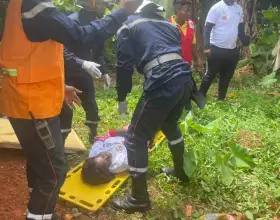MINUSCA Claims Only 44% Of CAR Territory Is Occupied By Rebels

Souleymane Thioune, the interim Director of Cabinet for the United Nations Multidimensional Integrated Stabilization Mission in the Central African Republic popularly known by its French acronym MINUSCA, has declared that the various armed groups fighting the government now occupy just 44 per cent of Central African Republic territory.
Thioune made the announcement during a weekly press briefing on Wednesday in the capital Bangui, but many in the country believe that more territories are occupied by the armed groups.
It is an open secret known locally and internationally that at least 75 per cent of Central African Republic territory has been occupied by armed groups since 2014 when the ongoing war broke out in the country.
“In fact, apart from the national capital Bangui, the government is not in complete control of anything and any territory outside the capital,” a western diplomat who declined to be named in the press because of his status told HumAngle in Bangui on Thursday.
“When one looks at the towns where the Blue Helmets of MINUSCA are based, the rebels are always around the corner. Can we then talk of the complete liberation of these towns?” asked a student of the University of Bangui who also did not want to be named.
He argued that there are towns that are not completely liberated as the UN diplomat would want the world to believe.
“The towns of Babari, Bria, Birao, Ndele, Alindao, Ippy etc are not completely liberated, thus we cannot count them among areas liberated from armed groups,”the said student added.
The general consensus among the local populations in the national capital Bangui is that recapture of the towns of Boali, Boda and Bossembele by the combined forces of MINUSCA, the national army popularly known by the French acronym FACA as well as Russian and Rwandan mercenaries cannot by any means reduce the territory occupied by armed groups to just 44 per cent.
“More than 70 per cent of the Central African Republic territory is still occupied by various armed groups,” an individual who gave his name to HumAngle in Bangui as Magloire Samba who claimed to be a strategy analyst said.
With Christian and Moslem armed groups of Anti-Balaka and Seleka now grouped under the Coalition of Patriots for Change (CPC), one can only envisage dark days for the government in Bangui, Samba argued.
“It is almost certain the rebels would capture more territory soon given the ferocious way they have been fighting FACA, MINUSCA and the foreign mercenaries from Russia and Rwanda.”
“On what basis did they arrive at this calculation? There is no truth in their assertion. Even if the Bangui-Beloko corridor is completely liberated, it is still estimated that not less than 75 per cent of Central African Republic territory is occupied by rebel groups,” our source insisted.
Support Our Journalism
There are millions of ordinary people affected by conflict in Africa whose stories are missing in the mainstream media. HumAngle is determined to tell those challenging and under-reported stories, hoping that the people impacted by these conflicts will find the safety and security they deserve.
To ensure that we continue to provide public service coverage, we have a small favour to ask you. We want you to be part of our journalistic endeavour by contributing a token to us.
Your donation will further promote a robust, free, and independent media.
Donate HereStay Closer To The Stories That Matter




